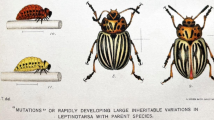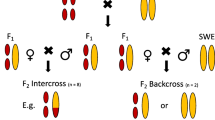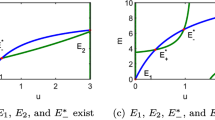Abstract
We explore the interaction between two genetic incompatibilities (underdominant loci in diploid organisms) in a population occupying a one-dimensional space. We derive a system of partial differential equations describing the dynamics of allele frequencies and linkage disequilibrium between the two loci, and use a quasi-linkage equilibrium approximation in order to reduce the number of variables. We investigate the solutions of this system and demonstrate the existence of a solution in which the two clines in allele frequency remain stacked together. In the case of asymmetric incompatibilities (i.e. when one homozygote is favored over the other at each locus), these stacked clines propagate in the form of a traveling wave. We obtain an approximation for the speed of this wave which, in particular, is decreased by recombination between the two loci but is always larger than the speed of “one cline alone”.



Similar content being viewed by others
References
Apreutesei N, Ducrot A, Volpert V (2009) Travelling waves for integro-differential equations in population dynamics. Disc Contin Dyn Syst Ser B 11(3):541–561
Barton NH (1979) The dynamics of hybrid zones. Heredity 43:341–359
Barton NH (1983) Multilocus clines. Evolution 37:454–471
Barton NH, de Cara MAR (2009) The evolution of strong reproductive isolation. Evolution 63:1171–1190
Barton NH, Gale KS (1993) Genetic analysis of hybrid zones. In: Harrison RG (ed) Hybrid zones and the evolutionary process. Oxford University Press, New York, USA, pp 13–45
Barton NH, Hewitt GM (1985) Analysis of hybrid zones. Ann Rev Ecol Sys 16:113–148
Barton NH, Hewitt GM (1989) Adaptation, speciation and hybrid zones. Nature 341:497–503
Bazykin AD (1969) A hypothetical mechanism of speciation. Evolution 23:685–687
Corbett-Detig RB, Zhou J, Clark AG, Hartl DL, Ayroles JF (2013) Genetic incompatibilities are widespread within species. Nature 504:135–139
Coyne JA, Orr HA (2004) Speciation. Sinauer Associates Inc, Sunderland MA
Fraïsse C, Elderfield JAD, Welch JJ (2014) The genetics of speciation: are complex incompatibilities easier to evolve? J Evol Biol 27:688–699
Gavrilets S (2004) Fitness landscapes and the origin of species. Princeton University Press, Oxford
Sattinger DH (1976) On the stability of waves of nonlinear parabolic systems. Adv Math 22(3):312–355
Slatkin M (1975) Gene flow and selection in a two-locus system. Genetics 81:787–802
Volpert V (2011) Elliptic partial differential equations. Volume 1: Fredholm theory of elliptic problems in unbounded domains, volume 101 of Monographs in mathematics. Birkhäuser/Springer Basel AG, Basel
Volpert VA, Volpert AI, Collet JF (1999) Topological degree for elliptic operators in unbounded cylinders. Adv Differ Equ 4(6):777–812
Zeidler E (1986) Nonlinear functional analysis and its applications. I. Springer-Verlag, New York (Fixed-point theorems. Translated from the German by Peter R, Wadsack)
Acknowledgements
Matthieu Alfaro is supported by the ANR project DEEV ANR-20-CE40-0011-01. Quentin Griette was partially supported by a PEPS-JCJC grant from CNRS (2019). Benoît Sarels thanks the Wolfgang Pauli Institute and the Faculty of Mathematics at the University of Vienna for a fruitful stay. The authors are grateful to the anonymous referees whose precise comments have improved the presentation of the results.
Author information
Authors and Affiliations
Corresponding author
Additional information
Publisher's Note
Springer Nature remains neutral with regard to jurisdictional claims in published maps and institutional affiliations.
A Some useful results and tools
A Some useful results and tools
We recall the Implicit Function Theorem, see Zeidler (1986, Theorem 4.B) for instance.
Theorem A.1
(Implicit Function Theorem) Let X, Y and Z be three Banach spaces. Suppose that:
-
(i)
The mapping \({\mathcal {F}}:U\subset X\times Y\rightarrow Z\) is defined on an open neighbourhood U of \((x_0, y_0)\in X\times Y\) and \({\mathcal {F}}(x_0, y_0)=0\).
-
(ii)
The partial Fréchet derivative of \({\mathcal {F}}\) with respect to y exists on U and
$$\begin{aligned} {\mathcal {F}}_y(x_0, y_0):Y\rightarrow Z \text { is bijective}. \end{aligned}$$ -
(iii)
\({\mathcal {F}}\) and \({\mathcal {F}}_y\) are continuous at \((x_0,y_0)\).
Then, the following properties hold:
-
(a)
Existence and uniqueness. There exist \(r_0>0 \) and \(r>0\) such that, for every \(x\in X\) satisfying \(\Vert x-x_0\Vert \le r_0\), there exists a unique \(y(x)\in Y\) such that \(\Vert y-y_0\Vert \le r\) and \({\mathcal {F}}(x, y(x))=0\).
-
(b)
Continuity. If \({\mathcal {F}}\) is continuous in a neighbourhood of \((x_0,y_0)\), then the mapping \(x\mapsto y(x)\) is continuous in a neighbourhood of \(x_0\).
-
(c)
Higher regularity. If \({\mathcal {F}}\) is of the class \(C^m\), \(1\le m\le \infty \), on a neighbourhood of \((x_0, y_0)\), then \(x\mapsto y(x)\) is also of the class \(C^m\) in a neighbourhood of \(x_0\).
In Sect. 4 we apply Theorem A.1 to the operator \({\mathcal {F}}\) defined in (26), with \(X=\mathbb R\), \(x=\varepsilon \), \(x_0=0\), \(Y=\mathbb R\times C^{2,\alpha }_\mu (\mathbb R)\), \(y=(c,h)\), \(y_0=(0,0)\), and \(Z=C^{0,\alpha }_\mu (\mathbb R)\).
Next, we quote some results on Fredholm operators. Let us recall that the operator L has the Fredholm property with index 0 if \(\ker L\) has a finite dimension, \(\mathrm{rg}\,L\) is closed and has finite codimension and
In particular, since its range is closed, such an operator is normally solvable:
and remark that \((\mathrm{rg}\,L)^\perp = \ker L^*\).
We recall below a theorem from Volpert et al. (1999, Theorem 2.1 and Remark p787).
Theorem A.2
(Fredholm property on the line) For \(0<\alpha <1\), consider the operator \(L:C^{2,\alpha }(\mathbb R)\rightarrow C^\alpha ({\mathbb {R}})\) defined by
where the coefficients a(x), b(x), c(x) are smooth, and \(a(x)\ge a_0\) for some \(a_0>0\). Assume further that the coefficients a(x), b(x), and c(x) have finite limits as \(x\rightarrow \pm \infty \) and denote
Finally, let us define the limiting operators
and assume that for any \(\lambda \ge 0\), the equation
has no nontrivial solution in \( C^{2,\alpha }({\mathbb {R}})\).
Then L is Fredholm with index 0.
Let us also recall a Fredholm property result for second-order ordinary differential equations, see the monograph of Volpert (2011, Chapter 9, Theorem 2.4 p. 366).
Theorem A.3
(Fredholm property for second-order ODEs) With the notations of Theorem A.2, the operator L is Fredholm provided the two equations
has no real solution \(\xi \in {\mathbb {R}}\). In this case the index of L is given by the formula
where \(\kappa ^\pm \) is the number of complex solutions to the characteristic equation
which have a positive real part.
Remark A.4
(Fredholm property in weighted Hölder spaces) We cannot directly apply Theorems A.2 and A.3 to our situation since we consider the operator L acting from \(C^{2, \alpha }_\mu (\mathbb R)\) into \(C^\alpha _\mu (\mathbb R)\), and not from \(C^{2,\alpha }(\mathbb R)\) into \(C^{0,\alpha }(\mathbb R)\). To circumvent this, we consider the operator \(L^\mu :C^{2, \alpha }({\mathbb {R}})\rightarrow C^\alpha ({\mathbb {R}})\) defined by:
Since \(T_\mu :u\in C^{2, \alpha }_\mu ({\mathbb {R}}) \mapsto e^{\mu \sqrt{1+x^2}}u\in C^{2, \alpha }({\mathbb {R}})\) is continuously invertible, and \(T_\mu ^{-1}:u\in C^{0, \alpha }({\mathbb {R}}) \mapsto e^{-\mu \sqrt{1+x^2}}u\in C^{0, \alpha }_\mu ({\mathbb {R}})\) is continuously invertible, the map \(L=T_\mu ^{-1}L^\mu T_\mu \) shares the same Fredholm property and index as \(L^\mu \). As a result, if \(L^\mu \) satisfies the assumptions of Theorem A.2, or Theorem A.3, then L is a Fredholm operator with the same index as that of \(L^\mu \).
Rights and permissions
About this article
Cite this article
Alfaro, M., Griette, Q., Roze, D. et al. The spatio-temporal dynamics of interacting genetic incompatibilities. Part I: the case of stacked underdominant clines. J. Math. Biol. 84, 20 (2022). https://doi.org/10.1007/s00285-022-01722-6
Received:
Revised:
Accepted:
Published:
DOI: https://doi.org/10.1007/s00285-022-01722-6
Keywords
- Genetic incompatibilities
- Underdominance
- Quasi-linkage equilibrium
- Standing wave
- Traveling wave
- Perturbation analysis




